Direct Capitalization Method
Method for valuing properties that produce income
It is a simple method for valuing properties that produce income. Real estate investors, appraisers, and analysts use a variety of strategies and procedures to value assets that provide an income.

The core idea behind the Direct Capitalization Method is to convert the asset's net operating income (NOI) into a projected property value. The net operating income is calculated by deducting operating expenses from the property's gross income.
Operating expenditures encompass all expenses incurred for property care, such as maintenance fees, taxes, insurance, and management fees.
The direct capitalization technique is a regularly used methodology in finance and real estate evaluation to determine the value of an asset that generates income. According to this method, a property's value and net operating income are closely related (NOI).
Investors and appraisers can determine the market worth of a property by applying a capitalization rate to its NOI.
The direct capitalization method offers a simple and efficient approach to valuing properties, particularly those with stable income streams and consistent operating expenses.

We will look at the basics of the direct capitalization approach, its essential components, and how it is used in real estate appraisal.
We will delve into the factors that influence the capitalization rate and discuss the limitations and considerations of this valuation approach.
Investors and real estate professionals may make more informed decisions and accurately assess the value of income-producing properties by learning more about the direct capitalization approach.
Key Takeaways
- The Direct Capitalization Method is a straightforward approach to valuing income-producing properties based on their net operating income (NOI) and capitalization rate (Cap Rate).
- It offers advantages such as simplicity, speed, market-based analysis, income focus, wide acceptance, and flexibility in selecting the appropriate Cap Rate.
- However, the method has limitations, including simplified assumptions, limited scope, reliance on market data, lack of consideration for financing, suitability for specific property types, and complex investment analysis.
- Yield capitalization is a more comprehensive method that considers future cash flows and discount rates, while direct capitalization focuses on current income and a capitalization rate.
- When valuing real estate properties, factors such as location, property size and condition, comparable sales, income potential, market conditions, future development, financing, and investor objectives should be considered.
Main Components of the direct capitalization method
Two main components are necessary to use the Direct Capitalization Method:
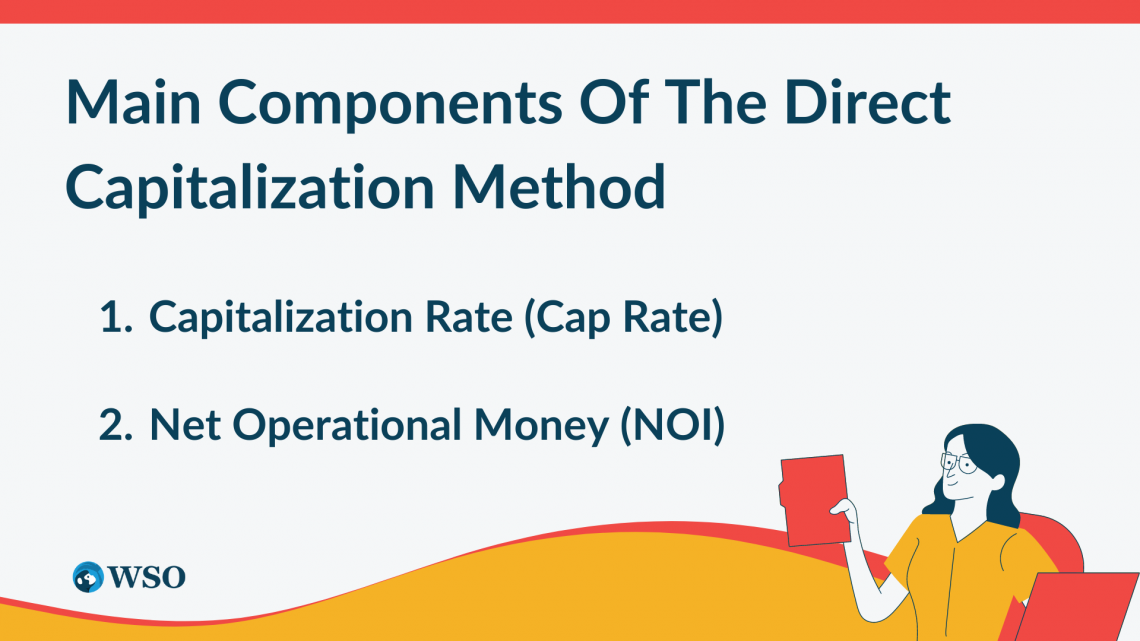
1. Capitalization Rate (Cap Rate)
A critical component of the Direct Capitalization Method is the Capitalization Rate (Cap Rate). It indicates the expected rate of return on an income-producing property for an investor.
The Cap Rate is generally calculated using market data and reflects the property's perceived risk and current market circumstances.
Many factors influence cap rates, including property type, location, market demand, property condition, lease periods, and overall economic situations.
Lesser Cap Rates indicate lower risk and greater property values, whereas higher Cap Rates indicate higher risk and lower property values.
2. Net Operational Money (NOI)
The Net Operating Income is the income earned by the property after deducting all operating expenditures. It reflects the yearly cash flow that an investor might expect from the property. NOI is derived by deducting operational expenditures from gross income.

Once the Cap Rate and NOI have been calculated, the property's worth may be assessed using the following formula:
Property Value = Net Operating Income / Capitalization Rate
The Direct Capitalization Method assumes a consistent revenue stream over the holding term and does not account for future appreciation, inflation, or changes in market circumstances.
As a result, it is best suited for assessing assets with a consistent revenue stream and steady market circumstances.
Advantages of the Direct Capitalization Method
The Direct Capitalization Method offers several advantages in the valuation of income-producing properties. Here are some key advantages:
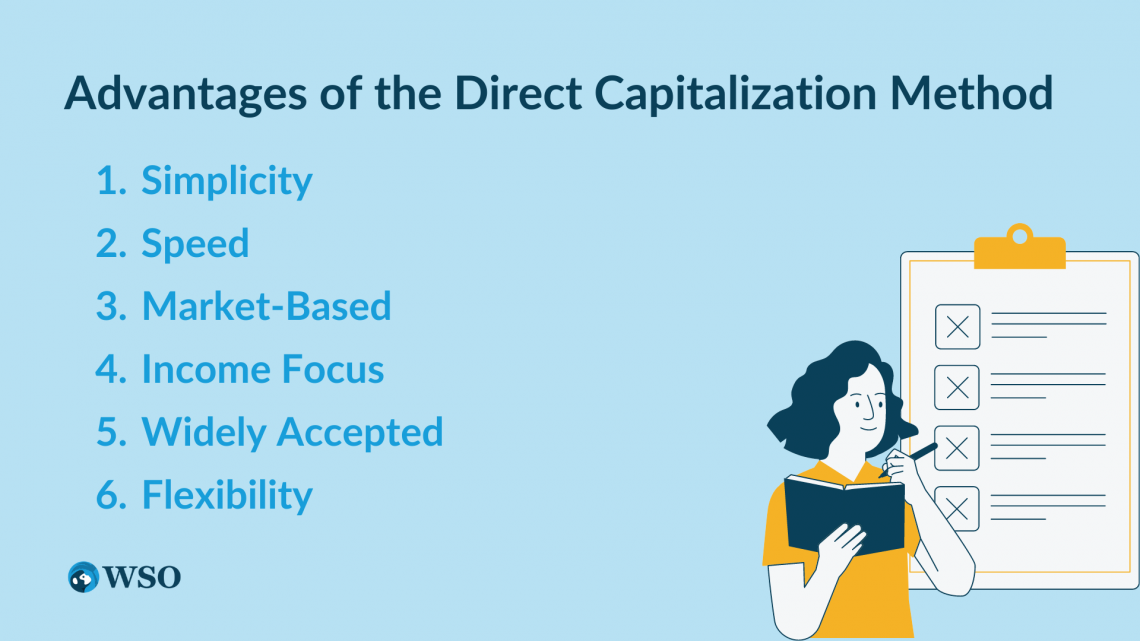
1. Simplicity
The Direct Capitalization Method provides a straightforward approach to property valuation.
It requires basic financial information such as net operating income (NOI) and a capitalization rate (Cap Rate), making it accessible to a wide range of investors, appraisers, and analysts.
Its simplicity allows for quick and efficient calculations, saving time and effort in the valuation process.
2. Speed
Compared to more complex valuation methods like discounted cash flow analysis, the Direct Capitalization Method provides a rapid property value estimate.
It is advantageous when time is critical, such as in initial investment analysis or when conducting preliminary property valuations. The method's efficiency allows for timely decision-making and facilitates the assessment of multiple properties within a short period.
3. Market-Based
The Direct Capitalization Method relies on market data, including Cap Rates derived from comparable sales and income data. This market-driven approach takes into account prevailing market conditions and investor expectations.
NOTE
By considering market data, the method provides a realistic and reliable estimate of property value based on actual market trends and investor perceptions.
4. Income Focus
The Direct Capitalization Method focuses directly on the income-generating potential of the property. It establishes a direct link between income and value, making it particularly suitable for income-producing properties, such as commercial real estate.
By considering the property's net operating income, the method provides valuable insights into the potential for generating cash flow.
5. Widely Accepted
The Direct Capitalization Method is widely accepted and recognized within the real estate industry. Its widespread acceptance ensures consistency and comparability in property valuations, making communicating and evaluating the value of income-producing properties easier.
6. Flexibility
While the method provides a simplified approach, it allows flexibility in selecting the appropriate Cap Rate. Investors and appraisers can adjust the Cap Rate based on their knowledge of the local market, property-specific factors, and risk preferences.

This flexibility enables customization of the valuation process to suit individual circumstances and specific property characteristics.
The Direct Capitalization Method offers several advantages in the valuation of income-producing properties. Its simplicity, speed, reliance on market data, focus on income, wide acceptance, and flexibility make it a valuable tool for estimating property value.
However, it is crucial to recognize the method's limitations and consider other factors when conducting a comprehensive property valuation.
Limitations and Considerations of the Direct Capitalization Method
While the Direct Capitalization Method is a widely used and valuable approach in property valuation, it also has certain limitations and considerations that should be considered. Here are some key limitations and considerations of the method:
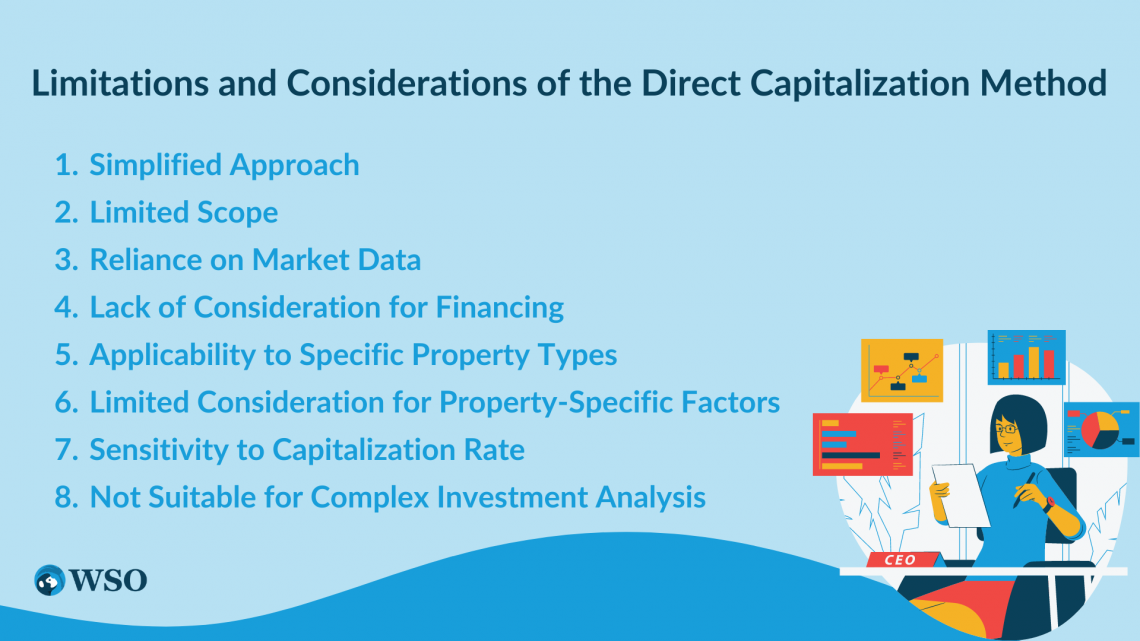
1. Simplified Approach
The Direct Capitalization Method depends on simplifying assumptions and generalizations. It assumes a stable income stream and a constant capitalization rate over the holding period.
In reality, market conditions, rental rates, expenses, and capitalization rates may fluctuate, making the method less accurate in dynamic or volatile markets.
2. Limited Scope
The Direct Capitalization Method focuses solely on the property's income stream. It does not consider other factors that can impact value, such as changes in market demand, economic conditions, or property-specific factors.
It may not capture the full range of variables that influence property value, leading to potential inaccuracies or oversights.
3. Reliance on Market Data
The method heavily depends on accurate and reliable market data, including comparable sales and income data. However, finding truly similar properties can be challenging, especially in unique or specialized markets.
NOTE
Inaccurate or insufficient market data can result in unreliable valuations.
4. Lack of Consideration for Financing
The Direct Capitalization Method does not explicitly account for financing costs or the impact of leverage on property value. It assumes an all-cash purchase, which may not reflect the reality of most real estate transactions.
Financing terms and interest rates can significantly affect the property's investment return and overall value.
5. Applicability to Specific Property Types
While the Direct Capitalization Method is commonly used for income-producing properties, it may only be suitable for some property types.

Specific property categories, such as properties with significant value derived from non-rental income sources (e.g., hotels and specialized facilities), may require alternative valuation methods to accurately capture their unique income streams and value drivers.
6. Limited Consideration for Property-Specific Factors
The method does not explicitly incorporate property-specific factors such as location, physical condition, tenant quality, lease terms, or potential for future rental growth.
These factors can significantly impact property value but still need to be fully addressed in the simplified approach of the Direct Capitalization Method.
7. Sensitivity to Capitalization Rate
Selecting an appropriate capitalization rate is crucial in the Direct Capitalization Method. Small changes in the capitalization rate can lead to significant variations in property value.
NOTE
The cap rate reflects investor expectations, risk perceptions, and market conditions, and different appraisers or investors may have different opinions on the appropriate rate to use.
8. Not Suitable for Complex Investment Analysis
The Direct Capitalization Method is primarily used for quick estimates or preliminary valuations. It may not be sufficient for in-depth investment analysis that requires a more comprehensive assessment of cash flows, property-specific risks, and future market conditions.
More sophisticated methods like discounted cash flow analysis may be more appropriate for such complex analyses.
NOTE
It is essential to recognize these limitations and considerations when utilizing the Direct Capitalization Method.
Factors to Consider When Valuing Real Estate Properties
These factors help assess the property's characteristics, market conditions, income potential, and overall investment attractiveness. Here are some important factors to consider when estimating the value of real estate:
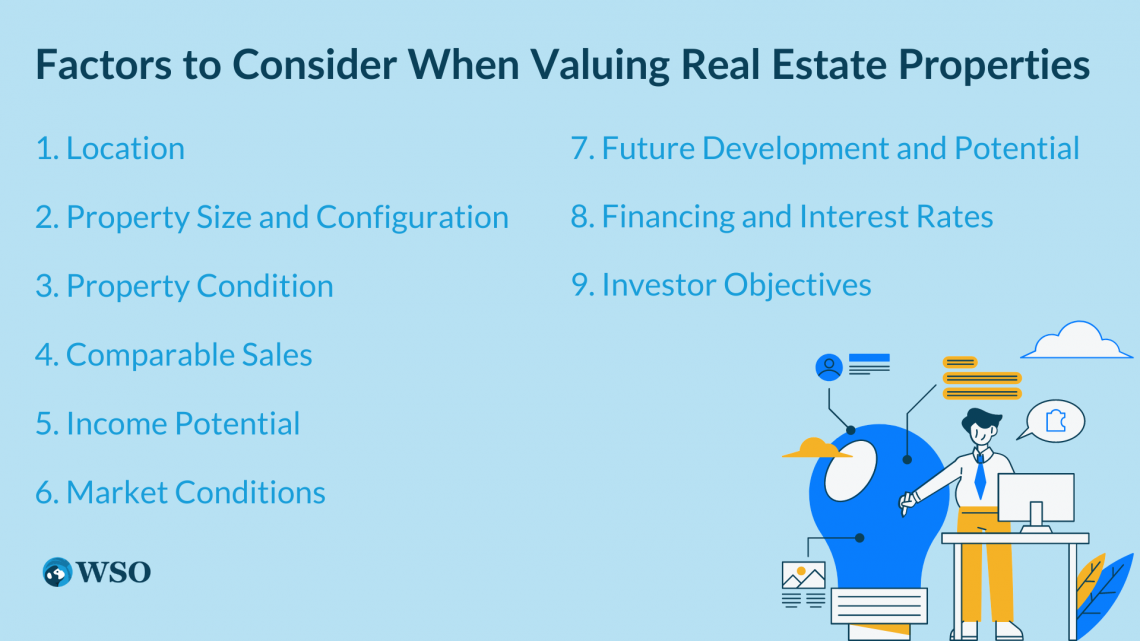
1. Location
Consider factors such as proximity to amenities, transportation, schools, employment centers, and the overall desirability of the neighborhood. Prime locations with high demand often have higher property values.
2. Property Size and Configuration
Evaluate the size and layout of the property. The total land area, floor area, number of units, rooms, and overall configuration can impact the property's value. Larger properties or those with flexible layouts and functional designs often command higher values.
3. Property Condition
Assess the property's overall condition, including the building structure, infrastructure, systems, and any necessary repairs or renovations. Well-maintained properties with updated features and modern amenities generally have higher values.
4. Comparable Sales
Look at recent sales of similar properties in the area, known as comparable sales or comps. These sales provide insights into the market value of properties with similar characteristics and can serve as a benchmark for estimating the subject property's value.
5. Income Potential
For income-producing properties, evaluate the income potential by analyzing the rental income, lease terms, occupancy rates, and rental market conditions.

6. Market Conditions
Market conditions can influence property values and the level of buyer or investor interest.
7. Future Development and Potential
Assess any potential for future development, zoning changes, or planned infrastructure projects in the area. Such factors can impact the property's value by introducing growth prospects or potential risks.
8. Financing and Interest Rates
Evaluate the prevailing financing conditions and interest rates. Access to favorable financing options and lower interest rates can increase the property's affordability and attractiveness to buyers or investors.
9. Investor Objectives
Take into account the specific objectives of the investor or buyer. Investors may have different investment strategies, risk tolerances, return expectations, and holding periods. Understanding the investor's perspective helps align the property's value with its investment goals.
Estimating a property's worth requires reliable, current data, thorough market research, and suitable valuation procedures.
Yield Capitalization And Direct Capitalization
Yield capitalization and direct capitalization are two commonly used methods in real estate valuation to determine the value of income-producing properties.

While both approaches involve estimating the value based on the property's income, their underlying principles and application differ.
1. Capitalization of Yield
A more extensive and complex valuation approach is yield capitalization, often called discounted cash flow (DCF) analysis. It considers the time value of money and the projected future cash flows of the property over a specified holding period.
The yield capitalization method involves discounting the property's expected cash flows to their present value using a discount rate, which represents the required rate of return or yield expected by an investor.
The key steps involved in yield capitalization are as follows:
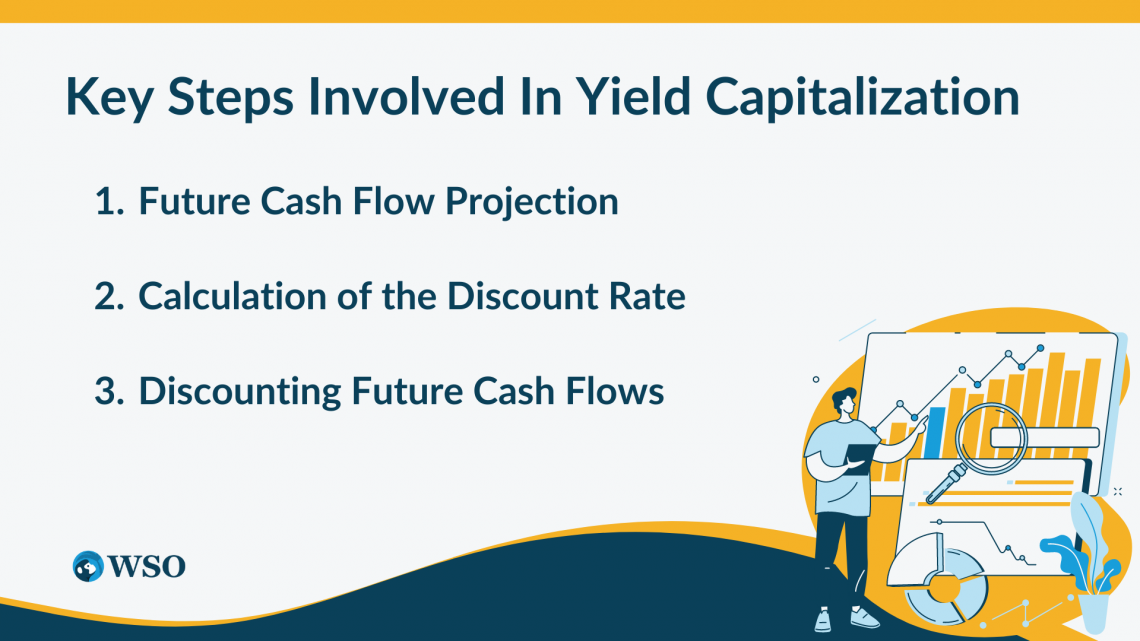
1. Future Cash Flow Projection
Estimate the property's predicted future cash flows, considering elements such as rental revenue, operational expenditures, vacancy rates, lease periods, and prospective income growth.
2. Calculation of the Discount Rate
Choose an acceptable discount rate depending on the property's risk profile, market circumstances, financing costs, and investor expectations. The discount rate represents the investor's required rate of return.
3. Discounting Future Cash Flows
Apply the discount rate to each projected cash flow to calculate its present value. The sum of these discounted cash flows represents the property's estimated value.
Yield capitalization provides a more detailed analysis by considering the timing and magnitude of future cash flows, which makes it suitable for properties with varying income streams, lease expirations, or significant changes expected in the future.
2. Capitalization through direct means
It involves converting the property's expected income stream into a present value by applying a capitalization rate. This method is commonly used for properties that generate stable and predictable cash flows, such as rental properties and commercial buildings.
The key steps involved in direct capitalization are as follows:

1. Net Operating Income (NOI) Calculation
Subtract operating expenditures from gross income to get the property's current net operating income.
2. Capitalization Rate Determination
Determine an acceptable capitalization rate based on market circumstances, property location, risk profile, and current rates of return.
3. Estimation of Property Value
Divide the property's net operating income by the capitalization rate to calculate its estimated value.
It is commonly used for properties with stable income and expenses and does not consider the timing or magnitude of future cash flows. The primary distinction between yield capitalization and direct capitalization is that future cash flows are considered.
Yield capitalization incorporates projected future cash flows, discounting them to their present value, while direct capitalization focuses solely on the property's current income and applies a capitalization rate.

Yield capitalization is more suitable for properties with varying income streams, lease expirations, or significant changes expected in the future. It provides a more detailed analysis of cash flows over time and considers the time value of money.
Direct capitalization, on the other hand, is commonly used for properties with stable income and expenses. It provides a quick and straightforward estimate of value based on the property's current income and prevailing market conditions.
In conclusion, yield and direct capitalization are valuable approaches in real estate valuation. The choice between the two methods depends on the property's characteristics, the availability of data, and the desired level of analysis.









or Want to Sign up with your social account?